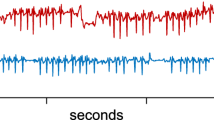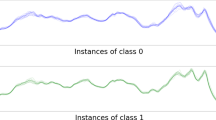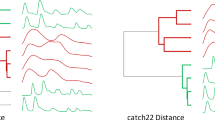Abstract
In the last years, there is a huge increase of interest in application of time series. Virtually all human endeavors create time-oriented data, and the Data Mining community has proposed a large number of approaches to analyze such data. One of the most common tasks in Data Mining is classification, in which each time series should be associated to a class. Empirical evidence has shown that the nearest neighbor rule is very effective to classify time series data. However, the nearest neighbor classifier is unable to provide any form of explanation. In this chapter we describe a novel method to induce classifiers from time series data. Our approach uses standard Machine Learning classifiers using motifs and characteristics as features. We show that our approach can be very effective for classification, providing higher accuracy for most of the data sets used in an empirical evaluation. In addition, when used with symbolic models, such as decision trees, our approach provides very compact decision rules, leveraging knowledge discovery from time series. We also show two case studies with real world medical data.
Access this chapter
Tax calculation will be finalised at checkout
Purchases are for personal use only
Preview
Unable to display preview. Download preview PDF.
Similar content being viewed by others
References
Buhler, J., Tompa, M.: Finding motifs using random projections. Journal of Computational Biology 9(2), 225–242 (2002)
Chiu, B., Keogh, E., Lonard, S.: Probabilistic discovery of time series motifs. In: Proceedings of the 9th International Conference on Knowledge Discovery and Data Mining, New York, USA, pp. 493–498 (2003)
Ferreira, P.G., Azevedo, P.J., Silva, C.G., Brito, R.M.M.: Mining approximate motifs in time series. In: Todorovski, L., Lavrač, N., Jantke, K.P. (eds.) DS 2006. LNCS (LNAI), vol. 4265, pp. 89–101. Springer, Heidelberg (2006)
Ding, H., Trajcevski, G., Scheuermann, P., Wang, X., Keogh, E.: Querying and Mining of Time Series Data: Experimental Comparison of Representations and Distance Measures. In: Proceedings of the VLDB Endowment, pp. 1542–1552 (2008)
Keogh, E., Zhu, Q., Hu, B., Hao, Y., **, X., Wei, L., Ratanamahatana, C.A.: The UCR Time Series Classification/Clustering (2011), http://www.cs.ucr.edu/~eamonn/time_series_data/ (accessed February 28, 2012)
Last, M., Kandel, A., Bunke, H.: Data Mining in Time Series Databases. Machine perception and artificial intelligence, vol. 57. World Scientific, Danvers (2004)
Lin, J., Keogh, E., Lonardi, S., Patel, P.: Finding motifs in time series. In: Proceedings of the Second Workshop on Temporal Data Mining at the Eighth Interntional Conference on Knowledge Discovery and Data Mining, Edmonton, Alberta,Canada, pp. 53–68 (2002)
Maletzke, A.G.: Uma metodologia para a extração de conhecimento em séries temporais por meio da identificação de motifs e extração de características. Master Thesis. Universidade de São Paulo, São Paulo, Brazil (2009)
Maletzke, A.G., Batista, G.E., Lee, H.D.: Uma avaliação sobre a identificaçãode motifs em séries temporais. In: Anais do Congresso da Academia Trinacional de Ciências, Foz do Iguaçu, Paraná, Brazil, vol. 1, pp. 1–10 (2008)
Maletzke, A.G., Lee, H.D., Zalewski, W., Oliva, J.T., Machado, R.B., Coy, C.S.R., Fagundes, J.J., Wu, F.C.: Estudo do Parâmetro Tamanho de Motif para a Classificação de Séries Temporais de ECG. In: Congresso da Sociedade Brasileira de Computação, Workshop de Informática Médica, Natal, Rio Grande do Norte, pp. 1–10 (2011)
Michalski, R.S., Bratko, I., Kubat, M.: Machine learning and data mining. Wiley, Chichester (1998)
Olszewski, R.T.: Generalized Feature Extraction for Structural Pattern Recognition in Time-Series Data. PhD Thesis, Carnegie Mellon University, Pitts-burgh, PA (2001)
Saad, L.H.C.: Quantificação da função esfincteriana pela medida da capaci-dade de sustentação da pressão de contração voluntária do canal anal. PhD Thesis, Faculdade de Ciências Médicas da Universidade Estadual de Campi-nas, Campinas, SP (2002)
Tanaka, Y., Iwamoto, K., Uehara, K.: Discovery of time-series motif from mul-tidimensional data based on mdl principle. Machine Learning 58(2-3), 269–300 (2005)
Witten, I.H., Frank, E.: Data mining: practical machine learning tools and techniques, 2nd edn. Elsevier, San Francisco (2005)
Author information
Authors and Affiliations
Corresponding author
Editor information
Editors and Affiliations
Rights and permissions
Copyright information
© 2014 Springer-Verlag Berlin Heidelberg
About this chapter
Cite this chapter
Maletzke, A.G. et al. (2014). Time Series Classification with Motifs and Characteristics. In: Espin, R., Pérez, R., Cobo, A., Marx, J., Valdés, A. (eds) Soft Computing for Business Intelligence. Studies in Computational Intelligence, vol 537. Springer, Berlin, Heidelberg. https://doi.org/10.1007/978-3-642-53737-0_8
Download citation
DOI: https://doi.org/10.1007/978-3-642-53737-0_8
Publisher Name: Springer, Berlin, Heidelberg
Print ISBN: 978-3-642-53736-3
Online ISBN: 978-3-642-53737-0
eBook Packages: EngineeringEngineering (R0)




